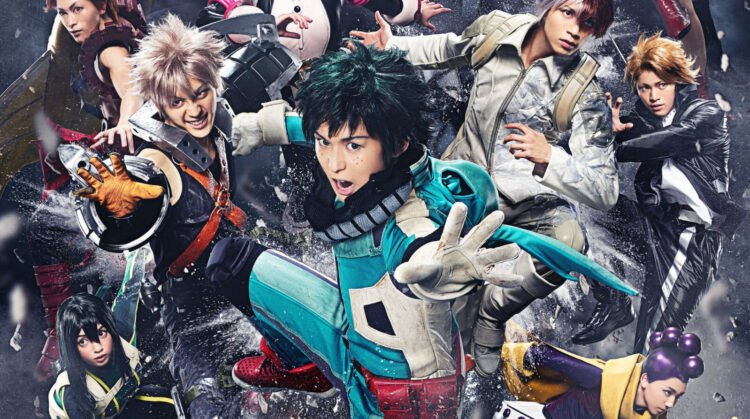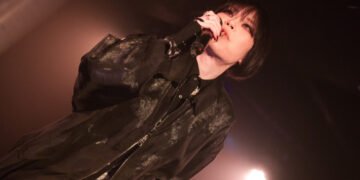This year the Anime, Manga & Game Online Festival was set up for the first time, allowing international fans to experience 2.D stage plays through streaming for the first time. Over the course of a month, fans could experience Naruto, Sailor Moon, and of course, the My Hero Academia plays with subtitles from the comfort of their living rooms. For those of you unaware, 2.5D stage plays are Japanese musical theatre productions based on anime, manga or video games, with the 2.5D meaning they are bringing the original 2D medium to life. Without further ado, let us dive into the My Hero Academia review.

Plot
The story revolves around season 1 of the anime and, despite condensing it all down to 2 hours, it doesn’t lose much of the plot points. Certain points are jumped through quickly with narration or it occurs through a performance in a song, such as the first bit when Deku meets All Might. In a really clever move, it can sometimes happen in the background whilst another event is going on. Where it can be easy to miss, it is particularly noticeable during the tournament arc at the end where quite a few fights are happening whilst the focus is on other characters having a conversation. To also cover up sections where actors needed to change costumes or change the stage, there were fourth wall break moments that were comedic and helped break up the tension. These were even made to work with streaming, directed at people watching from home, making you forget that you were watching this in your living room and not in a theatre. It worked as a good recap of the first part of the series, with another play being put together to adapt the next part of the series.
Music
For the most part, it was along the lines of what you can expect from a musical, strong orchestral backing to focus on the vocal performance. However, to capture the anime feel there were some more J-Rock style tracks, and some incorporation of guitar in others to give a consistent feel. In a way, it felt strange as it was a different way of delivering the emotions and building the tension of the scenes as in the anime it was more just background music. It helped make it feel different enough to not just be the show, having its own flair as some of the fight scenes were dances to the music that worked incredibly well. The songs were generally quite catchy and the cast had great singing voices. Even the mix was high quality as it sounded great through the television speakers. There seemed to be a main song called I Want to be a Hero which acted like the anime opening for the show, which they also closed with. It acted as a balance of all the songs, whilst also having the most anime feel out of all of them.
Cast and Costumes
Everyone was very well cast as each actor really brought out the character they were portraying, most even sounding like the original anime cast. All of them were very notable, yet Deku did steal the show with his ability to seemingly cry on queue. Still, for the whole cast it wasn’t just in the acting they captured the characters, but also the singing such as Bakugo having a more rough and grunting singing voice matching how he speaks. Although the only criticism is there are quite a few times actors have their backs to the audience unnecessarily. At times it was fine, but at others it was hard to see what was going on. Still, as a whole, the sense of stage positions was done really well, at times utilising running through the audience which was cool. Not only that, the costumes were very accurately replicated for the most part. Combined with the acting, it really felt like the characters were alive. There was the odd difference with the costumes to help with the production, the main one being Todoroki who had a white costume so they could project the ice and flames on him better. Overall it was a great job by all the actors involved.
Stage Production
Going into watching the performance, I was curious how they would do a lot of the action through a theatre medium and it was interesting seeing that in itself. For the most part, there was the use of projectors to provide various different things such as backgrounds, visual effects of the flashes and etc, but also even the word sound effects and when introducing characters had the written information. It truly worked to keep the feel of the My Hero Academia anime and made it more immersive. It was truly brought into force when a see-through screen was placed midway through the stage so you could see actors behind it, then they could project on that to create the 2.5D feel, such as when All Might unleashes his array of punches on Nomu, the Nomu was behind the screen whilst All Might was in front as they projected the fast looking punches on the screen. It was a true spectacle to watch.
Not only were there projections, there were some props but these were limited yet used effectively when needed. It was mainly down to bits of staging, which were either projected onto or just simply moved by the stagehands. For example, flying was done with a wedge that stagehands moved or there was a projection of lines to create the dynamic fast movement. The stagehands were also used to help the actors with the action scenes, such as flipping them over once they were hit, although there were times the actors were just thrown which was equally impressive. The only downside of streaming the production was the camera angles, as at times they were a bit strange and made it hard to see what was happening, particularly the stuff going on in the background. Still, it will always be best seeing it in person in the theatre.
Summary
Overall, the My Hero Academia 2.5D Stage Play was a really fun experience. The combination of a great production, cast and performance made for a truly fun evening. Where there were some downsides due to the livestream, hopefully as the world starts to open up again we can experience the plays in person again soon.
Rating: 80/100





















